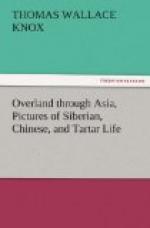The figures evidently came from Greek history, and I had little doubt that they were intended to tell of Alexander and Bucephalus. I learned that the words ‘Philip of Macedon’ were the literal translation of the Chinese title of the groups. How or when the Celestials heard the story of Alexander, and why they should represent it in stone, I cannot imagine. No one could tell the age and origin of these works of art.
On the walls of buildings near the temple there were paintings from Chinese artists, some of them showing a creditable knowledge of perspective. ‘John’ can paint very well when he chooses, and any one conversant with his skill will testify that he understands perspective. Why he does not make more use of it is a mystery that demands explanation.
When we entered the temple it was sunset, and the gathering shadows rendered objects indistinct. From the character of the windows and the colonnades outside I suppose a ‘dim religious light’ prevails there at all times. The temple contains several idols or representations of Chinese deities in figures larger than life, dressed with great skill and literally gotten up regardless of expense. Their garments were of the finest silk, and profusely ornamented with gold, silver, and precious stones. There were the gods of justice, peace, war, agriculture, mechanics, love, and prosperity. The god of love had a most hideous countenance, quite in contrast to that of the gentle Cupid with whom the majority of my readers are doubtless familiar. The god of war brandished a huge sword, and reminded me of the leading tragedian of the Bowery Theatre ten years ago. The temple was crowded with idols, vases, censers, pillars, and other objects, and it was not easy for our party to move about. In the middle of the apartment there were tables supporting offerings of cooked fowls and other edibles. These articles are eaten by the attendants at the temple, but whether the worshippers, know this fact or believe their gods descend to satisfy their appetites, I cannot say.
To judge from what I saw the Chinese are accustomed to decorate their houses of worship at great cost. There were rich curtains and a thousand and one articles of more or less value filling the greater part of the temple. Lanterns and chandeliers displayed the skill and patience of the Chinese in manipulating metals. There were imitations of butterflies and other insects, and of delicate leaves and flowers in metal, painted or burnished in the color of the objects represented. The aggregate time consumed in the manufacture of these decorations must be thousands of years. In a suspended vase I saw one boquet which was a clever imitation of nature, with the single exception of odor. The Chinese make artificial roses containing little cups which they fill with rose-water.
On our return we found the gate closed, and were obliged to wait until the ponderous key was brought to open it. The officer controlling the gate made no haste, and we were delayed in a crowd of Chinese men and dogs for nearly fifteen minutes. It was a peculiar sensation to be shut in a Chinese town and fairly locked in. It is the custom to close the gates of Kiachta and Maimaichin and shut off all communication between sunset and sunrise. The rule is less rigidly enforced than formerly.




